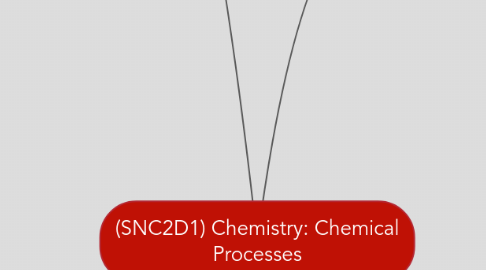
1. UNIT 5: NOMENCLATURE
1.1. DEFINITIONS
1.1.1. PURE SUBSTANCE: made up of only one kind of matter with a unique set of properties; is either an element or a compound
1.1.1.1. ELEMENT: a substance that cannot be broken down into any simpler substances by chemical means
1.1.1.2. COMPOUND: a pure substance made from two or more elements that are chemically combined
1.1.2. MIXTURE: a combination of pure substances with varying properties due to varying proportions of pure substances; comes as homogeneous and heterogeneous mixtures
1.1.2.1. HOMOGENEOUS MIXTURE: a mixture that looks the same throughout and the separate components are not visible; solutions are homogeneous mixtures
1.1.2.2. HETEROGENEOUS MIXTURE: a mixture where the different components are visible; there are mechanical mixtures and suspesions
1.1.2.2.1. SUSPENSION: a cloudy mixture in which tiny particles of one substance are held within another
1.1.2.2.2. MECHANICAL MIXTURE: made from several solids combined together
1.1.3. PROPERTIES
1.1.3.1. PHYSICAL PROPERTY: describes the physical appearance and composition of a substance; boiling and freezing point, malleability, ductility, colour, state, solubility, crystal formation, conductivity
1.1.3.2. CHEMICAL PROPERTY: describes the ability of a substance to change into a new substance or substances; combustibility, flash point, behaviour in air, reaction with water, reaction to heat
1.1.4. ATOMIC THEORY AND ATOMS
1.1.4.1. ATOMIC THEORY: the study of the nature of atoms and how atoms combine to form all types of matter
1.1.4.1.1. BOHR DIAGRAM: an illustration of an atom that shows the arrangement of and number of electrons in each shell
1.1.4.2. THE ATOM
1.1.4.2.1. SUBATOMIC PARTICLES
1.1.4.2.2. OTHER
1.1.5. THE PERIODIC TABLE
1.1.5.1. PERIODS: horizontal rows of the periodic table
1.1.5.2. FAMILIES (GROUPS): vertical columns in the periodic table; elements in the same family have similar physical and chemical properties
1.1.5.2.1. ALKALI METALS (group 1): soft, silvery-grey metals that react easily with water and oxygen in the air
1.1.5.2.2. ALKALINE EARTH METALS (group 2): silvery-grey metals that are harder and less reactive than group 1 metals; reactive atoms combine easily with other atoms
1.1.5.2.3. HALOGENS (group 17): coloured non-metals that are very reactive
1.1.5.2.4. NOBLE GASES (group 18): non-metal, colourless, odorless gases that are very nonreactive; nonreactive atoms do not combine with other atoms
1.1.5.3. METALS, NON-METALS AND METALLOIDS
1.1.5.3.1. METALS: elements that make up most of the periodic table and share the properties of being good conductors, malleable and ductile, shiny and usually silver in colour, and are solid at room temperature (with the exception of mercury) (found to the left)
1.1.5.3.2. NON-METALS: elements that share the property of being generally poor conductors (found to the right on the periodic table, with the exception of hydrogen which is on the left but is a non-metal)
1.1.5.3.3. METALLOIDS: elements with properties that are intermediate between the properties of metals and non-metals
1.2. OTHER
1.2.1. PREFIXES
1.2.1.1. MOLECULAR COMPOUNDS 1-> Mono- 2-> Di- 3-> Tri- 4-> Tetra- 5-> Penta- 6->Hexa- 7->Hepta- 8->Octa- 9->Nona- 10->Deca-
1.2.1.2. THERE ARE NO PREFIXES FOR COVALENT COMPOUNDS
1.2.2. EXAMPLES OF POLYATOMIC AND BINARY COMPOUNDS
1.2.3. SIDE NOTES
1.2.3.1. ADD "-ide" TO THE END OF THE SECOND ELEMENT IN COVALENT AND MOLECULAR COMPOUNDS
1.2.3.2. ATOMIC NUMBER: the number of protons in an atom of the element
1.2.3.3. ATOMIC MASS: the average mass of an atom of that element
1.2.3.4. ION: an atom or group of atoms with a negative or positive charge
2. UNIT 7: BALANCING EQUATIONS
2.1. BOTH SIDES OF THE EQUATION SHOULD EQUATE TO THE SAME TOTAL IONIC VALUE AND USE THE SAME AMOUNT OF ATOMS
2.2. EXAMPLE: 2NO(g) + O2(g) -> 2NO2(g)
2.3. SEE NOTES FOR MORE EXAMPLES
2.4. THE LAW OF CONSERVATION OF MASS: states that the mass of the products in a chemical equation are always equal to the mass of the reactants
3. UNIT 6: THE CHEMICAL REACTION
3.1. EXAMPLES OF CHEMICAL CHANGE
3.1.1. an unexpected change in colour
3.1.2. the production of heat, light or sound
3.1.3. the appearance or disappearance of an odor
3.1.4. the formation of a precipitate or gas
3.2. EQUATIONS FOR CHEMISTRY
3.2.1. WORD EQUATION: uses words and symbols
3.2.1.1. i.e. Hydrogen + Carbon Dioxide -> Carbon Monoxide + Water
3.2.2. FORMULA/SKELETAL EQUATION: uses the symbols and formulas for the chemicals
3.2.2.1. i.e. H2 (g) + CO2 (g) -> CO(g) + H2O(l)
3.3. TYPES OF CHEMICAL REACTION
3.3.1. SYNTHESIS
3.3.1.1. GENERAL EQUATION: A + B -> AB
3.3.1.2. EXAMPLE: 2Mg(s) + O2(g) -> 2MgO(s)
3.3.2. DECOMPOSITION
3.3.2.1. GENERAL EQUATION: AB -> A + B
3.3.2.2. EXAMPLE: CaCl2(s) -> Ca(s) + Cl2(g)
3.3.3. SINGLE DISPLACEMENT
3.3.3.1. GENERAL EQUATION: AB + C -> CB + A
3.3.3.2. EXAMPLE: 2KI(aq) + Br2(l) -> 2KBr(aq) + I2(aq)
3.3.4. DOUBLE DISPLACEMENT
3.3.4.1. NEUTRALIZATION
3.3.4.1.1. GENERAL EQUATION: HB (acid) + XOH (base) -> XB (ionic salt) + H2O(l)
3.3.4.2. GENERAL EQUATION: AB + CD -> AD + CB
3.3.5. COMBUSTION
3.3.5.1. GENERAL EQUATION: CxHy + O2 -> CO2 + H2O
4. UNIT 8: ACIDS AND BASES
4.1. SIMILARITIES AND DIFFERENCES OF ACIDS AND BASES
4.1.1. SIMILARITIES - dissolves in water - conduct electricity in aqueous solutions - can irritate or burn skin
4.1.2. DIFFERENCES
4.1.2.1. ACIDS: - taste sour - does not feel slippery - Ph less than 7 - turns blue litmus paper red - releases hydrogen ions (H+) in aqueous solutions - corrodes metals - reacts with metals to produce a compound and hydrogen gas
4.1.2.2. BASES: - tastes bitter - feels slippery - Ph more than 7 - turns red litmus paper blue - releases hydroxide ions (OH-) in aqueous solutions - does not corrode metals - does not react with metals to produce a compound and hydrogen gas
4.1.3. Ph Scale (runs from 1-14, 7 is neutral and water)
4.2. DEFINITIONS:
4.2.1. ACID-BASE INDICATOR: any substance that changes colour in the presence of an acid or a base (i.e. litmus paper)
4.2.2. NEUTRALIZATION: a chemical reaction between an acid and a base that produces water (H2O) and a salt
4.2.3. PRECIPITATE: the suspension of small particles formed during a chemical reaction

